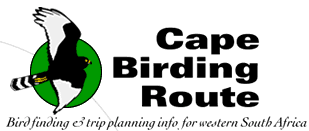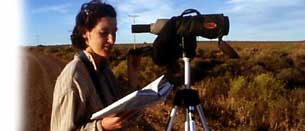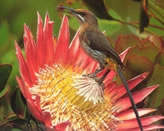| The Wilderness
Region:
At the western end of the Garden Route, the Wilderness National
Park encloses a system of reed-fringed coastal lakes which
are sandwiched between a beach and an escarpment cloaked with
lush coastal forest. A number of tranquil paths lead through
the forest, offering easy and pleasant access to an excellent
selection of forest birds, including Knysna
Lourie (p.125*). The park’s rest camp is at Ebb
and Flow (1 on site map, p.120), a 1-km drive north of the
N2 national road (turn inland at the signs just east of Wilderness
village). The hutted camp and campsite, particularly at Ebb
and Flow North (adjacent to Ebb and Flow south), offers good
birding (including nightly Wood Owls) and is a rewarding
place to base your explorations into the surrounding forests.
Leading
from Ebb and Flow are four trails, all named after local kingfishers.
Good forest birding is to be had along the Giant Kingfisher
Trail, which begins at the northern end of the Ebb and Flow
North campsite. It runs alongside the eastern bank of the
Touw River, ascending its forested valley and ultimately reaching
a waterfall at 2, 3.5 km from the campsite. The most conspicuous
species in the forest are usually Bar-throated Apalis
and Green-backed Bleating Warbler. Terrestrial Bulbul
and Chorister
Robin (p.125*) lurk in the lower strata (see box opposite),
while common species of the mid-canopy are Cape Batis,
Dusky Flycatcher, Sombre Bulbul, Yellow-throated
Warbler, Blue-mantled Flycatcher, Olive Woodpecker
and, less conspicuously, Olive Bush Shrike. It is especially
important to familiarize yourself with the calls of otherwise
cryptic canopy species such as Black-headed Oriole,
Narina Trogon
(p.125*), Grey Cuckooshrike, Scaly-throated Honeyguide,
Black-bellied Starling, Knysna
Lourie (p.125*), and Red-billed Woodhoopoe.
The latter two birds often venture into the rest-camp edges.
Look
out for Red-necked Francolin feeding cautiously in
open areas near the forest edge, especially in the early morning
and in the evening. Listen for the deep hoot of Buff-spotted
Flufftail at night. Crowned Eagle and African
Goshawk may be seen overhead here, as indeed in any of
the Garden Route forests. Cinnamon (the most common)
and Tambourine Doves are birds of the forest floor
and are most often seen when flushed.
Also
providing good access to these forest species is the Half-collared
Kingfisher Trail, running along the other side of the
Touw River for 2.5 km. It offers a good view of the river
edges, and thus better access to its scarce and inconspicuous
namesake, which is resident along its length. The reeds along
the Touw River at the Ebb and Flow campsite edges have hosted
Great Reed Warbler, which may be a scarce visitor here
despite being almost unknown in the Cape.
In
the Wilderness system, the best lakes for birding are Langvlei
and Rondevlei, largely because both have well-positioned hides
(at 3 and 4 respectively, see map overleaf) which are accessed
along boardwalks cut through dense reedbeds. These hides,
especially the one at Rondevlei, are excellent places to search
for stubborn skulkers such as Red-chested Flufftail
and African Rail. The best way to see these birds is
to lure them across the gap in the reeds formed by the boardwalk.
Baillon’s Crake also occurs here, but is less
likely to be enticed into view and is best searched for at
the reed edges in the early morning. Rallids aside, the lakes
offer a pleasant selection of more conspicuous species, including
Yellow-billed Egret, Purple Heron, African
Fish Eagle, Osprey (summer), African Marsh Harrier,
Malachite Kingfisher and Cape Reed and African
Sedge Warblers.
Excellent
forest birding (possibly even superior to that at Wilderness)
may also be enjoyed in Woodville Forest, just to the north
of the lakes (see map, above; follow the signs to the ‘Big
Tree’ at 5). A few minute’s walk from the parking
area leads you to the aptly named tree — a gargantuan
Outeniqua Yellowwood (Podocarpus falcatus) — from
which a 2-km footpath loops gently through the forest. All
the birds listed for the Wilderness forests occur here. Furthermore,
Woodville is probably a better site for Starred Robin,
Knysna
Woodpecker (albeit scarce; p.72*) and, in streamside
undergrowth and scrubby forest edge habitats, Knysna
Warbler (p.32*). Secondary growth at forest edges
— such as that along the short section of road leading
to the parking area — is worth checking for Forest
Canary, Swee Waxbill and Greater Double-collared
Sunbird.
Another
excellent site for Knysna
Warbler (p.125*) is Victoria Bay, situated between
Wilderness and George. Take the signposted turn-off south
from the N2 and follow this winding road all the way down
to the beach, where there is a gate and parking area. Knysna
Warbler is common in the undergrowth of the adjacent
dense coastal thicket (for example, near the boardwalk on
the left of the parking area).
Forest
Buzzard occurs in forests and
plantations throughout the Garden Route, and regularly perches
on roadside telephone poles along the N2 from Wilderness through
Knysna and to Nature’s Valley. In summer, it is joined
by Steppe Buzzard, posing an identification challenge.
|


